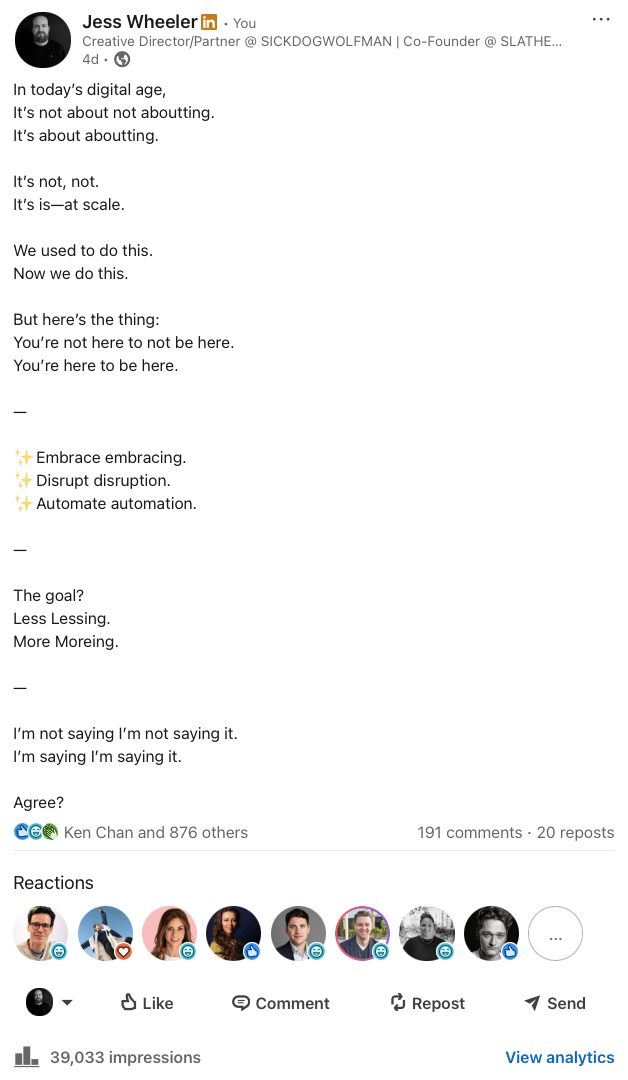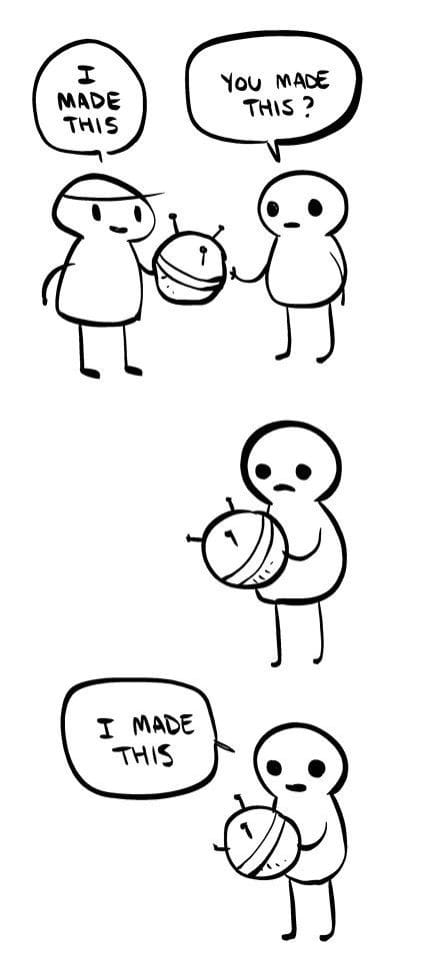- Death to shit ads.
- Posts
- Maths, monster trucks, and AI.
Maths, monster trucks, and AI.
And why you don't come up with ideas, you notice them.
“There is no such thing as a new idea. It is impossible. We simply take a lot of old ideas and put them into some sort of mental kaleidoscope” - Mark Twain
Or, simply put, ‘we don’t ‘come up’ with ideas, we notice them’.
Let’s take maths for example. (Bet you didn’t fucking see that coming.) There’s long been a philosophical debate about whether mathematics was ‘invented’ or ‘discovered’. (Another word for ‘noticed’). One can argue that the abstract system of symbols that humans conjured to measure, manipulate and understand everything around us is by definition an ‘invention’. However, if you then consider that everything observed by mathematics is simply proof that it has always existed, everywhere, in nature, in time, in space, then it becomes more-so a framework of understanding everything that we discover or notice over time. Pythagoras didn’t ‘invent’ a triangle, he simply noticed a ratio that was always there. (And, tbh, I wish he never did because I was instantly terrible at maths the second they started replacing numbers with letters and triangles and shit, but it’s a good example of how we don’t ‘come up’ with ideas - we notice them.)
Don’t like maths either? Ok, let’s talk monster trucks. In the early 80s a dude named Bob Chandler owned a 1974 Ford F-250. Due to the capitalistic joys of planned obsolescence, the drive train went and Ford had stopped producing the parts making it nearly impossible for Bob to fix his truck. Bob noticed that, given the popularity of these kind of trucks, there’d soon be a big market for fixing them. So he set up a specialty repairer. To make a huge deal out of his shop and his ability to work on these kind of trucks, he decided to make his own F-250 unique. So, naturally, he replaced the under-assembly of his truck with that of a military vehicle. (Classic Bob behaviour, tbh.) In short, he made it fucking huge. He named his now giant truck ‘Bigfoot’ and started driving it around to car shows. Noticing that people loved watching this giant freak of a machine drive over the top of stuff, so he decided to record a film of it jumping over and crushing old cars to promote his workshop. The video went whatever-you-would-call-viral-in-1981 and it led to other Bob’s wanting their trucks modified and the subsequent creation of ‘monster truck rallies’ that today is a multi-million-dollar subculture. Bob didn’t sit down one day and ‘come up’ with monster trucks, he started by just wanting to get his old truck fixed and along the way noticed a series of existing truths that eventually turned into the monster truck industry.
It’s why creativity is more a way of ‘being’ than ‘doing’. Tuning in. Being aware. Making connections. Developing a radar, an intuition, a palate, for noticing a convergence of different things that you can mush together into some other new exciting thing that lights you up inside.
“Discovery consists of seeing what everybody has seen, and thinking what nobody has thought.” - Albert Szent-Györgyi
It’s also why so many people are still misusing AI. I find the term ‘prompting’ (and ‘prompt engineer’…) to be quite a funny one. This notion that to come up with ideas you simply ‘prompt’ a machine and then copy and paste whatever it spits out and then claim that you ‘made it’. It’s true that AI is incredibly powerful at the mushing things together part, but it’s horrible at noticing what a good mushed up idea is.

We keep hearing that ‘AI writing is now indistinguishable from human writing’. Lol.
I wrote this post recently on LinkedIn. It basically says nothing, but a hell of a lot of people found it very funny. Because they immediately ‘got it’. They instantly recognised the patterns that are now present in a majority of content on the platform. They noticed what I noticed and what most people using AI like this apparently don’t have the radar to notice.
Because in the same way that you don’t come up with ideas, you notice them - you don’t prompt AI, AI prompts you.
Wait, what?
Yes. That’s right. AI prompts you. If you want to actually use it creatively, that is. Because anything else is just doing this.

“The more original a discovery, the more obvious it seems afterward.” - Arthur Koestler
In the early days of AI, Billy Corgan was already foreseeing where this was going to go. He described the future of AI in music as being not so dissimilar to what we already do now when composing music. We look at different riffs, bridges, hooks, lyrics, and then we use our discernment to select what resonates. The big difference with AI, of course, is volume. What might’ve been 20 riffs, could be 200. Or 2000. But without a level of human discernment, you still don’t actually have anything of value. And while acknowledging the potential benefits of AI, he importantly finished by saying, ‘If you think there’s a lot of bad music coming out now, just you wait’.
(Same goes for LinkedIn posts. Hence why we’re now drowning in a sea of hot emoji-fied garbage.)
And that’s because of the ‘discernment’ bit. The ‘noticing’. The inherent trait that 95% of people aren’t using or simply don’t have.
Much like this clip of Paul McCartney and The Beatles humming, toying with riffs, playing with melodies, testing rhythms, until everything melds together into ‘Get Back’ right in front of our eyes, the way (in my opinion, anyway) to use AI is to get it to prompt you.
Create an environment where things are flying at you for you to grab and latch on to and play with.
When solving a problem/responding to a brief, I’ve got a bunch of strategic instructions that I use to prompt AI to throw various ‘ways in’ at me. Strategic angles, behavioural truths, product or category insights. Most of what it produces is shit (much like humans), but out of each group of 20 there might be 1 or 2 points of interest. I put them to the side and then repeat, and repeat, and repeat, until I have a handful of interesting strategic veins. Then I keep tapping those, same process, over and over and over, I get it to prompt me with provocations and articulations of these territories and keep siphoning off the few curious bits and pieces. Then when I feel like I have enough interesting things to write to I go and write to it. I’ll repeat that bit - I GO AND WRITE IT. (AI cannot do the finished work. If you’re replacing all your people with AI, instead of employing creative people with discernment, then you’re completely missing the point.)
Much like Corgan mused, this process is not dissimilar from what I did pre-AI. The box method. Mind maps. Dan Nelken’s ‘100 ideas’ process. That kind of strategic work used to take days, weeks, months, but now I can do it in an hour or so. (Sometimes, if we’re honest and still keeping our bar high, it can still take time. Occasionally, you need hundreds of outputs and multiple re-strategisations to get 1 killer way in. AI, while phenomenal, is still not as good as people make it out to be. Yet. If you have standards, that is.)
In this sense, it’s like having a large hadron collider in your pocket. Creatives can now smash things together at warp speed and actively spot the anomalies that fly out of the machine. Then take those and riff on them. Just like they did before in their own minds. But at a much faster pace.
We recently pitched on a new piece of business and in the pitch were asked ‘how many copywriters do you have?’. We have more than one, of course, but at this stage, it was just myself on the brief. But the volume and sheer variation of quality insights provided a scale of work that once would’ve appeared like it came from an entire department. We won the business.
Biased opinion, sure, but this is what agencies using AI should look like. Not churning out copy and pasted prompt-slop.
Because you don’t come up with ideas, you notice them.
And you don’t prompt AI - it prompts you.
Reply